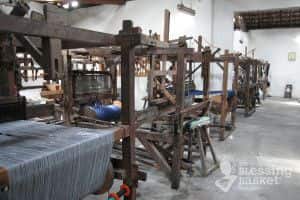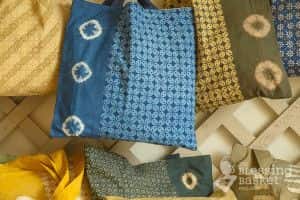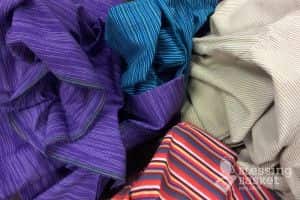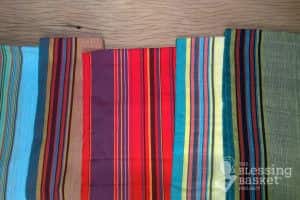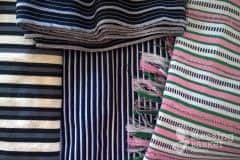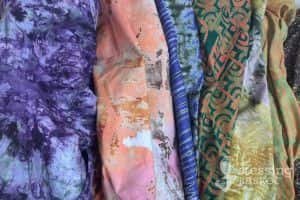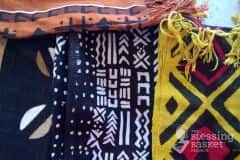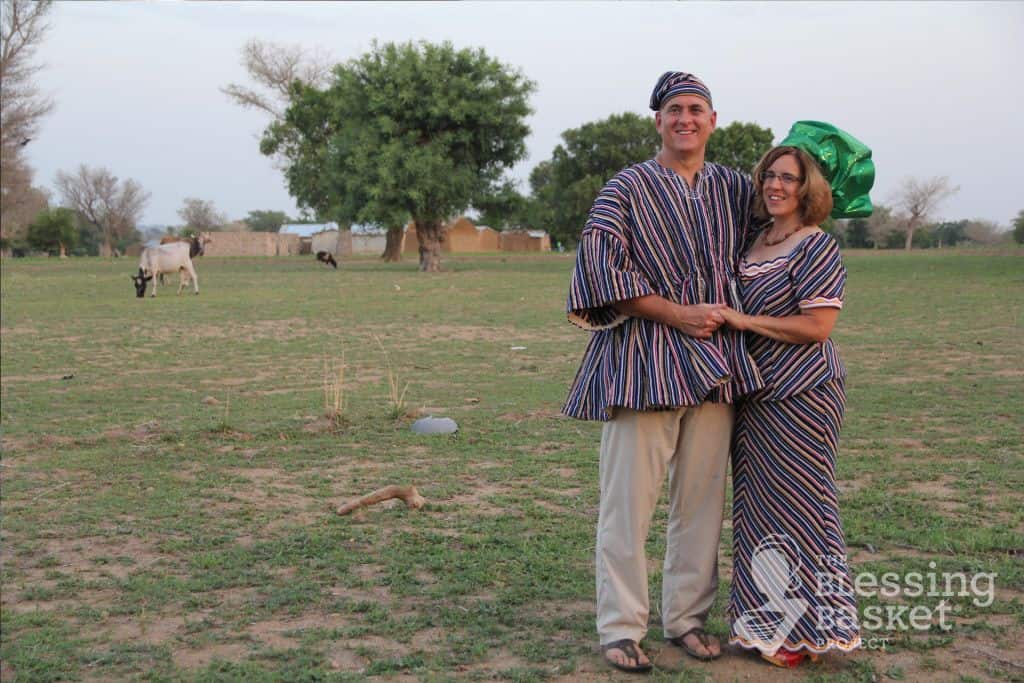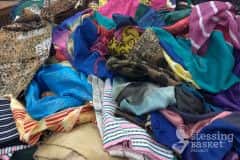This year at Expo West, fabrics sourced from communities where Whole Planet Foundation funds microcredit were sent down the runway at the fashion show, Beauty in All Beings. Many people contributed to making this inaugural event a spectacular success. In this guest post, our friend and partner Theresa Carrington, CEO of The Blessing Basket Project shares a behind the scenes look at what went into sourcing fabrics.
It’s 3am and my buzzing phone wakes me from a dead sleep. It’s Nin, Blessing Basket country director from Indonesia. It’s late afternoon there and Nin needs me to see what patterns and colors she has put together for the lurik and batik fabrics we are making for Whole Foods Market. Over the next two hours, one instant message and one photo at a time, we narrow it down.
It will be a subtle striped lurik pattern and a beautiful two-color batik, accented with a centuries old motif called kawung.
Colors, shapes, and patterns in both lurik and batik fabrics often have a deep spiritual meaning in Indonesia. For example, on our totes the kawung (the oval looking symbol) is one of the oldest designs and was once reserved for the royal family. It represents a cross section of the aren-palm fruit. Some say the cross between the four ovals refers to the universal energy source. Lurik fabric from Indonesia is also steeped in spirituality and tradition.
The purple lurik motif was previously worn only by Sultan, the king of Yogyakarta. The motif symbolizes hope and prayer for rain. The sultan wore this motif during a very dry season when people suffered from hunger. When the artisan chooses the colors and patterns in lurik they often choose symbols and colors to represent their life philosophy, hopes, and dreams. The invention of modern weaving machinery all but wiped out these traditional hand woven fabrics. Today, however, traditional batik and lurik production is seeing resurgence thanks to a handful of dedicated organizations. Nin not only is our country director, but she also runs one such organization. The Blessing Basket Project is proud to support her work by providing Prosperity Wages® and a market to traditional lurik and batik artisans.
With exhausted thumbs and strained eyes, Nin and I wrap our conversation. No sooner than my head hits the pillow, Uganda is calling in.
It’s Sarah, Blessing Basket Project country director for Uganda and Kenya.
Just two days earlier, Sarah’s first shipment of fabrics had arrived. The kikoi and linen were my favorites, but unless we could find the actual producers, we couldn’t present these hand-woven beauties to Whole Food Market.
“Get on Skype sister! Get on Skype,” she shouts excitedly. “I am here! With them!”
I’m up.
Sarah has been searching for two days for a kikoi weaving group. She’s finally found them and they want to meet the American lady who is so interested in their work. In the dark, I make my way to the kitchen table and fire up Skype. There – smiling back at me – is Dennis, the proud owner of 25 looms and the employer of over 50 kikoi and linen weavers. Despite the unreliable internet connection out of Uganda and threat of a low battery on Sarah’s computer, we are able to have an exciting 90 minute discussion. Dennis assures me the kikoi color combinations will be endless, and yes, the linen is made out of cotton. The weavers learned about our exclusive Prosperity Wages® model and were excited that they would be linked directly to their buyers in the United States through our unique Artisan&You® program.
Kikoi is a traditional East African fabric dating back to the first century. Worn mainly by Arab traders, kikoi would become part of the traditional clothing for Kenyan and East African fishermen. Known for its comfort, light weight and brilliant colors, kikoi made the perfect clothing for the hot African sun. Kikoi has evolved into stunning scarves and wraps for women.
By 11am, I excitedly arrive at Blessing Basket’s world headquarters in St. Louis. The DHL international shipment from Ghana I’ve been tracking for the last two days has finally arrived. I open the box and out tumbles beautiful guretana, motana, and batik fabrics. The hand-waxed batiks are stunningly beautiful, and Ghana’s proud heritage shines through the motana.
Abdulai, our country director in Ghana, has worked tirelessly for a week to make sure his West African heritage is strongly represented. Previously reserved for chiefs and royalty, motana is adorned with stylized adinkra symbols. The weaving is done on a hand loom as one incredibly long piece and can be worn and fashioned into many types of clothing, such as a scarf or a dashiki. Along with the motana, the guretana, a traditional cotton cloth, is striking. Guretana is thick and woven in very long three inch wide strips. Each strip is then sewn to the next and fashioned into clothing such as a traditional smock worn by those living in the Upper East Region of Ghana.
I was married in Ghana. It was a traditional village wedding and everyone was wearing beautiful guretana. Both guretana and motana are woven with such skill they can last for more than a century, when handled with care.
Ghana’s heritage fabrics join the others from across the six countries that The Blessing Basket Project serves and our conference table now looks like an international bazaar.
I sort, study, and photograph the fabrics well into the evening. My phone buzzes. Our Bangladeshi country director, Chandan, is up and wants to talk fabrics….
To stay updated on news from Theresa and her team, like The Blessing Basket Project on Facebook and follow Theresa on Twitter.

